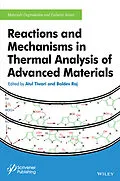Strong bonds form stronger materials. For this reason, the investigation on thermal degradation of materials is a significantly important area in research and development activities. The analysis of thermal stability can be used to assess the behavior of materials in the aggressive environmental conditions, which in turn provides valuable information about the service life span of the materiel. Unlike other books published so far that have focused on either the fundamentals of thermal analysis or the degradation pattern of the materials, this book is specifically on the mechanism of degradation of materials. The mechanism of rapturing of chemical bonds as a result of exposure to high-temperature environment is difficult to study and resulting mechanistic pathway hard to establish. Limited information is available on this subject in the published literatures and difficult to excavate. Chapters in this book are contributed by the experts working on thermal degradation and analysis of the wide variety of advanced and traditional materials. Each chapter discusses the material, its possible application, behavior of chemical entities when exposed to high-temperature environment and mode and the mechanistic route of its decomposition. Such information is crucial while selecting the chemical ingredients during the synthesis or development of new materials technology.
Autorentext
Dr. Atul Tiwari is a research faculty member in the Department of Mechanical Engineering at the University of Hawaii, USA. He has received Ph.D. in Polymer Materials Science along with the bestowed Chartered Chemist and Chartered Scientist status from the Royal Society of Chemistry, UK. Dr. Tiwari is an active member of several professional bodies in the UK, USA, and India. Being an organic chemist and mechanical engineer his research work tends to bridge the gap between the science and engineering. Dr. Tiwari has published more than sixty peer reviewed research publications. His area of research interest includes the development of smart materials including silicones, graphene and bio-inspired biomaterials for industrial applications. Dr. Tiwari zeal to develop new materials and has generated six international patented/pending technologies that have been transferred to the industries. He is an active consultant to renowned companies and acts as associate editor of international journals.
Baldev Raj is a distinguished scientist and former director of Indira Gandhi Centre of Atomic Research, India. He has pioneered the application of Non Destructive Testing (NDT) for basic research using acoustic and electromagnetic techniques in a variety of materials and components. He is currently President, International Institute of Welding, President, Indian National Academy of Engineering and President-Research PSG Institutions, Coimbatore. He is a member of the Scientific Advisory Council to Prime Minister, Scientific Advisory Council to Cabinet, Nano Mission Council of India and Apex Advisory Committee, Ministry of Human Resources Development. He is Chairman, Board of Governors, IIT, Gandhinagar & NIT, Puduchery.
Inhalt
Preface xv
Part 1: Degradation of Polymers
1 Thermal Stability of Organic Monolayers Covalently Grafted on Silicon Surfaces 3
Florent Yang, Philippe Allongue, Francois Ozanam and Jean-Noel Chazalviel
1.1 Introduction 3
1.2 Alkyl-Grafted Surfaces 8
1.3 Alkoxy-Grafted Surfaces 15
1.4 Surfaces Grafted with Aryl Groups 19
1.5 Surfaces Grafted via SiN Linkages 22
1.6 Summary 27
References 30
2 Thermal Analysis to Discriminate the Stability of Biomedical Ultrahigh-Molecular-Weight Polyethylenes Formulations 39
Maria Jose Martinez-Morlanes and Francisco Javier Medel
2.1 Introduction 39
2.2 Suitability of TGA Analysis for the Study of Stability of Medical Polyethylene 42
2.3 Activation Energies of Degradation Processes in the Thermal Decomposition of UHMWPE 56
References 58
3 Materials Obtained by Solid-State Thermal Decomposition of Coordination Compounds and MetalOrganic Coordination Polymers 63
Oana Carp
3.1 Introduction 63
3.2 Coordination Compounds and MetalOrganic Coordination Polymers as Precursors of Oxides 65
3.3 Coordination Compounds and MetalOrganic Coordination Polymers as Precursors of Sulfides 72
3.4 Coordination Compounds as Precursors of Composites 74
3.5 Coordination Compounds and MetalOrganic Coordination Polymers as Precursors of New Complexes 74
3.6 Coordination Compounds and MetalOrganic Coordination Polymers as Precursor of Metals 75
3.7 Coordination Compounds as Precursor of Nitrides 76
3.8 Other Materials 77
3.9 Conclusions 77
References 78
4 Methods for Limiting the Flammability of High-Density Polyethylene with Magnesium Hydroxide 85
Joanna Lena, Maria Sozaska and Henryk Rydarowski
4.1 Introduction 85
4.2 Experimental Part 88
4.3 Results and Discussion 91
4.4 Conclusions 99
References 100
5 Thermal Analysis in the Study of Polymer (Bio)-degradation 103
Joanna Rydz, Marta Musio and Henryk Janeczek
5.1 Introduction 103
5.2 Differential Scanning Calorimetry 105
5.3 Dynamic Mechanical Analysis 112
5.4 Thermogravimetric Analysis 115
5.5 Conclusions 120
Acknowledgments 121
References 121
6 Thermal and Oxidative Degradation Behavior of Polymers and Nanocomposites 127
Gauri Ramasubramanian and Samy Madbouly
6.1 Introduction 127
6.2 Thermal Degradation 131
6.3 Chemical and Oxidative Degradation 137
6.4 Photo-oxidation 143
6.5 Environmental and Biological Degradation 148
6.6 Degradation of Polymer Nanocomposites 154
6.7 Conclusions 162
References 162
7 Thermal Degradation Effects on Polyurethanes and Their Nanocomposites 165
Ivan Navarro-Baena, Marina P. Arrieta, Alicia Mujica-Garcia, Valentina Sessini, Jose M. Kenny and Laura Peponi
7.1 Introduction 165
7.2 Main Techniques Used for Studying the Thermal Degradation Process 167
7.3 Degradation Mechanisms 169
7.4 Chemical Approaches Used to Improve the Thermal Stability of PU 171
7.5 Thermal Degradation of PU Based on Natural Sources 172
7.6 Nanocomposites 174
7.7 PU Electrospun Fibers 181
7.8 Conclusions 184
References 184
8 Controllable Thermal Degradation of Thermosetting Epoxy Resins 191
Zhonggang Wang
8.1 Introduction 191
8.2 Ester-, Carbamate-, and Carbonate-Linked Reworkable Epoxy Resins 193
8.3 Ether-Linked Reworkable Epoxy Resins 195
8.4 Phosphate- and Phosphite-Linked Reworkable Epoxy Resins 196
8.5 Sulfite-Linked Reworkable Epoxy Resins 204
References 207
9 Mechanism of Thermal...
